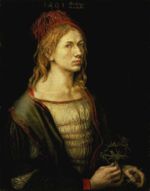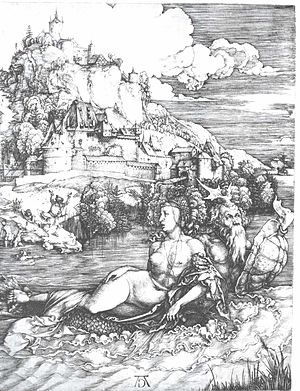- The Sea Monster
-
The Sea Monster (German: Das Meerwunder) is a c. 1498–1500 engraving by the German Renaissance master Albrecht Dürer. It shows a voluptuous naked middle-aged woman riding on the back of a male creature who is half-man, half-fish. The man wears a beard and antlers, while his body is covered in scales.[1] The woman has seemingly been snatched and dragged away from the river bank; her companions are shown scrambling out of the water in panic, raising their arms in protest or lying down weeping. The woman wears an extravagant Milanese headdress[2] and her mouth is open in a cry as she looks back at her friends in the distance.[3] Despite the woman's gaze back at the bank and her open mouth, her relaxed Venus like pose suggests that she is not overly concerned with her plight.
For this reason writer Jonathan Jones described the engraving as a "troubling, wondrous image of the erotic",[1] while historian Walter L. Strauss notes that her abduction may be a device to legitimise her nudity.[4] A fortress is set on the rock high above the river; elements of its structure echo the Kaiserburg in Nuremberg.[2]
This engraving is one of Dürer's early studies of anatomy and proportion, before he was able to arrive at what he saw as the canon of human beauty in his 1504 Adam and Eve. The image can be approximately dated due to a similar nude study held in the Albertina in Vienna which Dürer signed and dated 1501.[3] A well regarded Mannerist copy was completed c. 1550 in Germany, which shows the scene in mirror image. The copy is signed IoHann Von Essen.[3]
It is not known which specific classical or contemporary tale Dürer sought to illustrate; he is known to have synthesised different sources and bring motifs together in a single image. The abduction of a woman by a water-god is one of the oldest Greek mythological conceptions and a subject that fascinated men through to the Renaissance.[5] Dürer adds a layer of complexity to the scene in that the woman does not seem too upset at her fate.[6]
Vasari gave an early description of the work, through a vague description of a picture of a nymph set in the ancient world. Recent interpretations mention the abduction of Scylla by the sea demon Glaucus, or the abduction of Hesione by a monster. Further speculation centres on Anna Perenna, who escapes from Aeneas with the aid of a horned water-god.[7] Art historian Jane Campbell Hutchison suggests that the Milanese headdress may refer to the Lombard queen Theodelinda, who was also abducted by a sea monster.[2] The horned Tritonesque figure echoes a description given by Poggio Bracciolini of a sea monster that had terrorised the Adriatic coast in the early 15th century.[8]
Notes
- ^ a b Jonathan, Jones. "Divine inspiration". The Guardian, 30 November 2002. Retrieved 2 July, 2010.
- ^ a b c Campbell Hutchison, 35
- ^ a b c Nürnberg, 36
- ^ Strauss, Walter L. "The complete engravings, etchings, and drypoints of Albrecht Dürer". Dover Publications, 1973. ISBN 0-4862-2851-7
- ^ Brion, 153
- ^ Brion, 157
- ^ Campbell Hutchison, 50
- ^ Strauss, 46
References
- Brion, Marcel. Dürer. London: Thames and Hudson, 1960
- Campbell Hutchison, Jane. Albrecht Dürer, A Guide to Research. New York: Garland, 2000
- Nürnberg, Verlag Hans Carl. Dürer in Dublin: Engravings and woodcuts of Albrecht Dürer. Chester Beatty Library, 1983
Albrecht Dürer Paintings Portrait Diptych of Dürer's Parents (1490) · Portrait of Dürer's Father at 70 (1497) · Haller Madonna (c. 1498) · Lamentation of Christ (attributed, c. 1498) · Portrait of Oswolt Krell (1499) · Portrait of Elsbeth Tucker (1499) · Seven Sorrows Polyptych (c. 1500) · Lamentation of Christ (c. 1500) · Bagnacavallo Madonna (before 1505) · Christ among the Doctors (1506) · Portrait of a Young Venetian Woman (1505) · Feast of the Rosary (1506) · Avarice (1507) · Praying Hands (c. 1508) · Adam and Eve (1507) · Martyrdom of the Ten Thousand (1508) · Life of the Virgin (1510-1511) · Portrait of Emperor Maximilian I (1519) · Portrait of a Man (1521 or 24) · Portrait of Bernhart von Reesen (1521) · Portrait of Saint Jerome (1521) · The Four Apostles (1526) · Portrait of Hieronymus Holzschuher (1526) · Portrait of Jakob Muffel (1526)
Self-portraits Self-Portrait at the age of 13 (drawing, 1484) · Self-Portrait c 1492 (drawing, 1492) · Self-Portrait (1493) · Self-portrait at 26 (1498) · Self-Portrait at 28 (1500)Still life / nature View of Arco (1495) · Three Linden Trees (c. 1494) · The House by the Pond (c 1497) · Young Hare (1502) · Little Piece of Turf (1502) · Great Piece of Turf (1503) · Wing of a Roller (1512) · Rhinoceros (1516)Woodcuts / engravings The Child Jesus Holding the Globe (1493) · Dürer's Wife Anges (1494) · The Muse Thalia (1495/96) · Angel with a Lute (1497) · Apocalypse (1498) · Saint Michael Fighting the Dragon (1498) · The Four Witches (1497) · The Sea Monster (1498-1500) · Saint Sebastian at the Column (1500) · Visitation (1503) · Joachim and Anne Meeting at the Golden Gate (1504) · Knight, Death and the Devil (1513) · Melencolia I (1514) · Saint Jerome in His Study (1514) · Triumphal Arch (1515) · Head of a Walrus (1514)Drawings Portrait of the artist's mother at the age of 63 (1514)Alterpieces The Jabach Alterpiece (c. 1500) · The Heller Alterpiece (c. 1508) · Adoration of the Trinity (1511)Categories:- Engravings
- Renaissance art
- 1490s works
- Dürer paintings and prints
Wikimedia Foundation. 2010.


